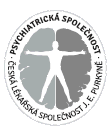Česká a slovenská psychiatrie

Časopis
Psychiatrické společnosti ČLS JEP
a Psychiatrickej spoločnosti SLS
původní práce / original article
HETEROGENITA VZORCOV PITIA MEDZI VYSOKOŠKOLÁKMI: ÚLOHA REZILIENCIE, VNÍMANÉHO STRESU, ÚZKOSTI A DEPRESIE
THE HETEROGENEITY OF DRINKING PATTERNS AMONG COLLEGE STUDENTS: THE ROLES OF RESILIENCE, PERCEIVED STRESS, ANXIETY, AND DEPRESSION
Adam Kurilla1,2,4, Michal Turček2,3, Daniel Dančík1,2,3, Alexandra Straková1, 2, Jakub Januška1,2, Ján Pečeňák2,3, Michal Hajdúk1,2,3, Anton Heretik1,2
1 Department of Psychology, Faculty of Arts, Comenius University in Bratislava, Slovakia
2 The Centre for Psychiatric Disorders Research, Science Park, Comenius University in Bratislava, Slovakia
3 Department of Psychiatry, Faculty of Medicine, Comenius University in Bratislava, Slovakia
4Centre for Treatment of Drug Dependencies in Bratislava, Slovakia
2 The Centre for Psychiatric Disorders Research, Science Park, Comenius University in Bratislava, Slovakia
3 Department of Psychiatry, Faculty of Medicine, Comenius University in Bratislava, Slovakia
4Centre for Treatment of Drug Dependencies in Bratislava, Slovakia
This work is an output of the following project: Comenius University Science Park supported by the Research and Development Operational Programme funded by the ERDF (grant number: ITMS 26240220086).
SÚHRN
Kurilla A, Turček M, Dančík D, Straková A, Januška J, Pečeňák J, Hajdúk M, Heretik A. Heterogenita vzorcov pitia medzi vysokoškolákmi: Úloha rezilien-cie, vnímaného stresu, úzkosti a depresie
Cieľ: Cieľom tejto štúdie bolo identifikovať potenciálne homogénne podskupiny vysokoškolských študentov na základe ich profilu pitia alkoholu a následne ich porovnať z hľadiska demografických údajov, úzkosti, depresie, vnímaného stresu a reziliencie.
Metódy: Nábor účastníkov (N = 1282; 80 % žien) bol robený medzi vysokoškolskými študentmi počas pandémie COVID-19 a z nej plynúcich obmedzení na Slovensku. Priemerný vek participantov bol 22,06 roka. Participanti vyplnili online prieskum pozostávajúci z batérie dotazníkov merajúcich psychopatológiu. Na odhadnutie rôznych podskupín pitia alkoholu medzi vysokoškolákmi bola použitá analýza latentných tried (LCA) na položkách testu Alcohol Use Disorders Identification Test (AUDIT). Tieto podskupiny boli následne porovnané v demografických a psychopatologických charakteristikách s využitím testu jednocestná ANOVA.
Výsledky: LCA odhadla tri podskupiny: ľahkí konzumenti (55,2 %), rizikoví konzumenti (35,4 %) a problémoví konzumenti (9,4 %). Problémoví konzumenti mali najvyššiu úroveň vnímaného stresu, depresie a úzkosti, a zároveň najnižšiu odolnosť.
Záver: Študenti s profilom problémového pitia sa od rizikovo pijúcich študentov líšil najmä dôsledkami pitia a frekvenciou nárazového pitia alkoholu. Rozdiely medzi výsledkami tejto štúdie a predchádzajúcich výskumov možno do určitej miery pripísať situácii spojenej s prebiehajúcou pandémiou COVID-19 v čase zberu údajov.
Klíčová slova: podskupiny užívania alkoholu, vysokoškolskí študenti, vzorce pitia, analýza latentných tried, psychopatologické charakteristiky
SUMMARY
Kurilla A, Turček M, Dančík D, Straková A, Januška J, Pečeňák J, Hajdúk M, Heretik A. The heterogeneity of drinking patterns among college students: the roles of resilience, perceived stress, anxiety, and depression
Objective: This study aims to identify potential homogeneous subgroups of college students based on their drinking patterns and then compare them on demographics, anxiety, depression, perceived stress, and resilience.
Methods: Participants (N = 1282; 80% females) were recruited among college students during lockdown in the COVID-19 pandemic in Slovakia. The mean age of participants was 22.06 years. They completed an online survey consisting of a battery of questionnaires measuring psychopathology. The Latent Class Analysis (LCA) on Alcohol Use Disorders Identification Test (AUDIT) items was utilized to estimate different drinking subgroups among college students. These subgroups were then compared on demographic and psychopathological characteristics using one-way ANOVA.
Results: The LCA estimated three subgroups: light drinkers (55.2%), at-risk drinkers (35.4%), and problem drinkers (9.4%). Problem drinkers had the highest levels of perceived stress, depression, and anxiety as well as the lowest resilience.
Conclusion: Participants with problem drinking profile differed from at-risk drinking students mainly by the consequences of drinking and the frequency of binge drinking. The differences between the findings of the present study and previous research could be attributed to some extent to the situation associated with the ongoing COVID-19 pandemic at the time of data collection.
Key words: alcohol use subgroups, college students, drinking patterns, Latent Class Analysis, psychopathological characteristics
INTRODUCTION
College students are a group that have a higher risk of excessive drinking and its harmful consequences.1-4 Problem drinking is more prevalent among college students than among non-college young adults (27% vs. 19%).5 Blanco et al.1 estimated that as many as 20% of college students meet the criteria for alcohol use disorder (AUD). This is most likely due to the contextual influences that come with life in college, but they can also affect people who do not attend college - for example, those living without parental supervision and among a large group of peers.6 Consequences of college drinking include impaired academic performance, injuries, sexual assaults, alcohol overdoses, memory blackouts, changes in brain function, lingering cognitive deficits, and potentially even death.3
AUD is an extremely heterogeneous condition and its subtyping has a long tradition. There has recently been a shift from earlier binary typologies, that are considered reductionist, to current, more complex multi-class classifications.7-9 These are ussually based on statistical clustering techniques, and they encompass a wide range of clinical and demographic factors.
In the college student population, there have been several attempts to identify homogeneous subtypes of alcohol consumers using the LCA. These studies identified two to six subgroups depending on the measures and statistical approach.10-19 There is a similar pattern that is consistently shown in the literature. While in the lower severity subgroups the frequency and quantity of drinking are satisfactory distinguishing features, in the higher severity subgroups the differences in the frequency and amount of consumed alcohol are blurred and problems due to excessive drinking are a more sensitive discriminating feature.10,14,17,19 Also, lower levels of self-regulation,10,14 higher perceived stress, lower life satisfaction,10 drinking as a coping strategy,13,16 and lower self-efficacy18 were more prevalent in subgroups with more drinking-related problems.
Research also established a connection between internalising psychopathology and alcohol use in young adults.20,21 In the college student population, studies seeking to identify separate subtypes based on anxiety, depressive symptoms, and alcohol use show that the higher severity of negative affect and drinking problems are interrelated.22,23
The identification of subgroups among risk populations has substantial implications for screening, prognosis estimation, prevention, and treatment strategies.14,20,24 The aims of the present study are therefore twofold. Firstly, based on the drinking patterns, this study would like to identify homogeneous subgroups of alcohol users using a data-driven approach based on the LCA.25 The secondary aim is to compare identified subgroups on demographics, psychopathology, perceived stress, and resilience.
METHODS
Participants
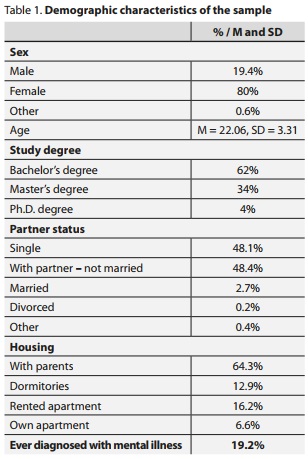
Participants (n = 1282) were recruited as a part of a larger study focusing on mental health among college students.26 The study used a subsample of participants with complete responses on all AUDIT items in the current analysis. The obtained sample did not differ in basic demographic parameters such as gender and age compared to the original sample. More detailed characteristics of the research population are presented in Table 1.
Procedure
Participants completed an online survey from 4 to 27 December 2020. This was part of screening for a study on the mental health of students during lockdown due to the COVID-19 pandemic. The students had been contacted via university e-mail. The completion of the survey was voluntary. We did not provide reimbursement to participants. The data were collected before the peak of the second wave of COVID-19 pandemic in Slovakia. The Ethics Committee of the Faculty of Arts of Comenius University in Bratislava approved the study.
Measures
The Alcohol Use Disorders Identification Test (AUDIT)27 is a ten-item measure designed to identify individuals who are at risk for alcohol use disorders. The time reference of the AUDIT is the past year, although some items have no specified time period. It contains scales measuring consumption (three items) and consequences (seven items). Each item is rated on a five-point Likert-type scale (e.g. 0 [never] to 4 [ daily or almost daily]) or a three-point Likert-type scale (e.g. 0 [ no], 2 [yes, but not in the last year], and 4 [yes, during the last year]). The scores are calculated by adding up the items. The total range is from a minimum of 0 to a maximum of 40, with a score of 8 or more indicating hazardous or harmful alcohol use.28-30 Previous research supports the validity and reliability of AUDIT with college student samples.29, 31 Cronbach´s alpha in the present study was α = .79.
The Brief Resilience Scale (BRS)32 is a six-item self-reporting scale assessing the ability to recover from stress. The time reference is indefinite. Each item is rated on a five-point Likert-type scale as "1" (strongly disagree) to "5" (strongly agree) and items 2, 4, and 6 are reversed. The total range of scores is from a minimum of 6 to a maximum of 30 and is divided by the number of items. The BRS showed a good reliability and validity among college student samples.33 In the present study, Cronbach´s alpha was α = .82.
The Perceived Stress Scale - 4 Items (PSS-4)34 is a four-item self-reporting scale assessing psychological stress. The time reference of the PSS-4 is the past month. Each item is rated on a five-point Likert-type scale as "0" (never) to "4" (very often), and items 2 and 3 are reversed. The total range of the score is from a minimum of 0 to a maximum of 16. Higher scores mean higher levels of psychological stress. The PSS-4 showed good reliability and validity among college student samples.35 In the present study, Cronbach´s alpha was α = .75.
The Patient Health Questionnaire (PHQ-9)36 is a nine-item measure which scores each of the nine DSM-IV criteria for depressive disorder as "0" (not at all) to "3" (nearly every day). The time reference of the PHQ-9 is the past two weeks. Scores are calculated by adding up the items. The total range of the score is from a minimum of 0 to a maximum of 27. The PHQ-9 has shown good psychometric properties in samples of college students.37,38 In the present study, Cronbach´s alpha was α = .88.
The Generalized Anxiety Disorder (GAD-7)39 is a seven-item self-reporting anxiety questionnaire. The time reference of the GAD-7 is the previous two weeks. Each item is rated on a four-point Likert-type scale as "0" (not at all) to "3" (nearly every day). The scores are calculated by adding up the items. The total range of scores is from a minimum of 0 to a maximum of 21. The GAD-7 has shown good reliability and validity among college student samples.40,41 In the present study, Cronbach´s alpha was α = .90.
Data analysis
Descriptive statistics were used to describe the research sample and bivariate correlations to find relationships between the analysed scale variables. A chi-square test of independence was performed to examine the relationship between gender, study degree, partner status, housing situation and drinking profiles.
The LCA25 was used for untangling the heterogeneity of response patterns on the AUDIT items. In general, the LCA is a statistical tool for the identification of unobserved qualitatively distinct subgroups in populations based on a set of predictors (dimensions). The LCA allows for the analysis of relationships in categorical and ordinal data. The R package poLCA42 was utilised for class estimation. Several models were sequentially fitted with an increasing number of classes (2-5). Models were compared using Akaike Information Criteria (AIC), Bayesian Information Criteria (BIC), likelihood ratios, and entropy values. Lower values of AIC and BIC and their derivates (aBIC and cAIC) and higher entropy values indicate better fit of model to the observed data. The best fitting model was selected based on the combination of fit indices as well as theoretical justification, parsimony, and interpretability. This approach for best model selection is in line with recent guidelines for conducting LCA.43 One-way ANOVAs were conducted to compare estimated classes on age, AUDIT, BRS, PSS-4, PHQ-9, and GAD-7. Levene´s test was used to test the assumption of the homogeneity of variances. Based on these results, either Tukey´s or Games-Howell´s post hoc comparisons were then used.
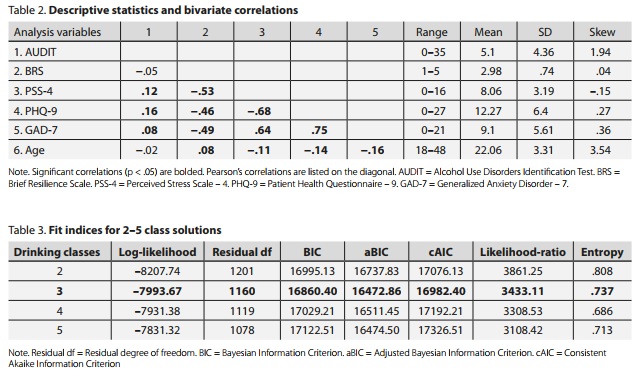
RESULTS
The mean age of participants was 22.06 years (SD = 3.31) with a range from 18
to 48 years. Females comprised 80% (
Table 2 displays the descriptive statistics and bivariate correlations for scale study variables. The vast majority of participants (96.65%) reported some alcohol consumption, meaning they scored at least one point in the AUDIT. A score of eight or more in the AUDIT was reached by 21.3% of the test sample.
The best fitting model consisted of three latent classes. This model had the lowest AIC and BIC values and the second highest level of entropy. Additionally, distinction on three subgroups is highly interpretable. Light drinkers were the largest group (55.2%) followed by at-risk drinkers (35.4%) and problem drinkers (9.4%). Table 3 displays all estimated fit indices for 2-5 class solutions.
Figure 1 displays the latent classes across the AUDIT items. In the problem drinking class, no participant scored less than eight points in the AUDIT. In the at-risk drinking class, 33% of participants scored eight or more points and in the light drinking class it was 0.4%. Genders were not equally distributed across classes. Men had a higher representation in the higher drinking classes and for women it was the opposite, the higher representation was in the lower classes: χ2(4) = 30.47, p < .001, V = .11. Study degree (χ2(4) = 2,625, p = .62, V = .03), partner status (χ2 (8) = 11.96, p = .153, V = .07) , and housing situation ( χ2 (6) = 4.12, p = .66, V = .04) were equally distributed across classess.
The results of one-way ANOVAs with effect sizes are in Table 4. Except for age, post hoc comparisons were conducted. Levene´s tests were not significant in terms of BRS, PSS-4, or GAD-7, so Tukey´s HSD test was used. In the case of AUDIT and PHQ-9, Levene´s tests were significant (p < .001 and p < .05). As a result, Games-Howell´s post hoc comparisons were used.
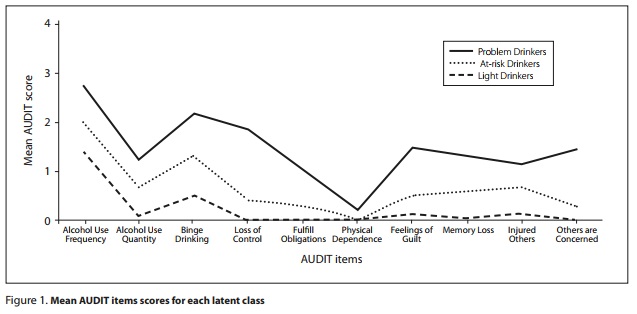
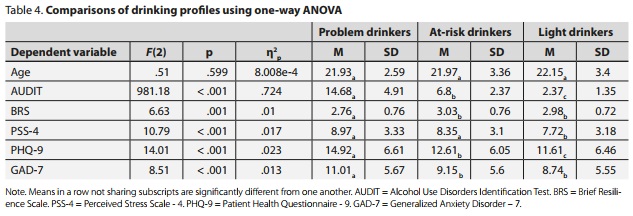
DISCUSSION
The results of the LCA estimated three latent classes according to their scores in the individual items of the AUDIT: problem drinkers, at-risk drinkers, and light drinkers. The results do not align with previous research using similar data-driven approaches in the college student population, where four subgroups were usually identified.11,13,14
At-risk drinkers differed from light drinkers mainly in their binge-drinking frequency. As binge drinking is known to have harmful consequences,44 at-risk drinkers also scored higher in items that measure harmful drinking - especially in memory loss and injuring others; however, these differences were not as prominent as in the binge-drinking item. Problem drinkers scored highest in all AUDIT items; however, what mostly distinguished them from at-risk drinkers was their binge-drinking frequency, loss of control, an inability to fulfil obligations, feelings of guilt, memory loss, and others being concerned about their drinking.
Similar to previous studies, the problem drinking profile differed from others especially in the negative consequences of drinking;14,19 however, these results did not completely replicate a very similar study by Kuvaas et al.,14 which had identified four subgroups: problem drinkers, heavy drinkers, moderate drinkers, and light drinkers. Kuvaas et al.14 state that problem and heavy drinkers did not differ in their alcohol consumption and that moderate drinkers differed from light drinkers in the frequency and amount of alcohol consumed on each occasion.
The majority of our research sample were females. Female college students drink less than men,45 but when they do drink, they experience more negative consequences of drinking compared to men.46 Nevertheless, our findings are consistent with previous research15 and showed that males were overrepresented in the class of problem drinkers and females were overrepresented in the class of light drinkers. There was no difference between the classes in the other measured demographic characteristics.
Is also important to consider the fact that the data collection was conducted during the peak of the second wave of the COVID-19 pandemic in Slovakia and during a nation-wide lockdown. Despite AUDIT´s time reference being the past year, consumption items do not specify time reference. In a study conducted on Slovak college students by Gavurová et al.45 with a very similar method and timing of data collection during the lockdown, the mean AUDIT questionnaire score was almost one point higher. This difference is probably a result of the fact that only drinking students were included in the research sample of this study and the sample was more balanced in terms of gender representation. However, still in favour of women. Alcohol consumption declined during the COVID-19 pandemic in almost all European countries, including Slovakia.47 Among college students population, Bollen et al.48 found that the alcohol consumption of students decreased during lockdown among previously heavy drinking students with enhancement and social motives but not among those with drinking alcohol as coping strategy, which is typical for problem drinkers.13, 16 Conversely, previously low drinkers with coping and social motives to drink increased their consumption.48 At the same time, in general, the binge-drinking prevalence among college students decreased during lockdown.49 Alcohol use during lockdown increased among students with higher levels of depression and anxiety.50 Depression and anxiety increased among students during the pandemic in general.26 Looking at these findings in the context of the presented results, it can be assumed that problem drinkers and some moderate and light drinkers are likely to increase their consumption during lockdown whereas heavy drinkers have alleviated it. This may have contributed to observed differences in the number of identified subgroups as well as in alcohol consumption between the subgroups, which does not fully correspond to previous research. While obtaining robust and stable results is inherently desirable, alcohol consumption is historically and socially conditioned51 and at the same time - its repeated measurement is important for planning prevention and treatment strategies in a dynamic environment.
In addition, problem drinkers were characterised by the highest levels of perceived stress, depression and anxiety, and the lowest levels of resilience. This is in line with previous research;10,22,23 however, problem drinkers did not differ significantly from at-risk drinkers in the level of perceived stress. Depression and anxiety severity and lower resilience were significantly different, which, in addition to drinking problems, can be another reliable distinguishing indicator between these subgroups. At-risk drinkers showed higher levels of perceived stress and depression compared to light drinkers.
Screening, prevention, and treatment implications
For screening problem drinking in college students using AUDIT, the proposed cut-off score of > 828-30 seems to be reliable as no participant in the problem drinking subgroup scored fewer than 8 points. In the at-risk subgroup, roughly two thirds of the participants scored fewer than 8 points, meaning that a lot of individuals who are at risk of developing drinking problems could be undetected when only looking at the total score of the AUDIT. On the other hand, there was a small number of participants in the light drinking subgroup who scored more than 8 points. A more detailed analysis of whether these were false positive results would be required. Specific AUDIT items seem to be more sensitive for the identification of problem drinking in college students than others: these are binge-drinking frequency, loss of control, failing to fulfil obligations, feelings of guilt, memory loss, and other people showing concern. Binge-drinking frequency seems to be the best distinguishing feature between light and at-risk drinkers, which aligns with previous findings.14,29,52
Consistent with previous research,11,13,14 it was found that there was a special group of problem drinkers among students who, on average, have moderately severe depression,36 moderate anxiety,39 and low resilience.32 In terms of prevention, using protective behavioural strategies in at-risk adolescents brings positive results.53 Treatment interventions should target problematic alcohol use as well as depressive and anxiety symptoms. Psychotherapeutic interventions, such as motivational interviewing and a cognitive behavioural approach, are recommended. In the case of the at-risk drinking subgroup, a brief intervention may be sufficient.54 These traditional face-to-face approaches can be effectively complemented and, in some cases, replaced by ecological momentary interventions using smartphones.55,56
Given the increase in depression and anxiety among college students during the COVID-19 pandemic in Slovakia26,57 and the fact that more depressed and anxious students are at risk of increased alcohol consumption,50 a focus on education and prevention programs at the population level would be desirable.
Limitations
The results presented here need to be interpreted in the light of several limitations. The cross-sectional design of the present study does not allow for the determination of which condition precedes another one - e.g., whether depressive and anxiety symptoms lead to problematic alcohol use and vice versa. It can be speculated that the global pandemic and lockdown might have driven the observed findings; however, future studies might shed some light on whether this three-class solution is stable or rather pandemic-related. Another limitation of the LCA is that the inclusion of other variables into a class estimation might lead to a different conclusion, but this was outside the scope of the present study. It is also problematic to draw conclusions about the general student population. The method of recruiting participants could lead to selfselection bias. In addition, women were overrepresented in the sample, which is a common disproportion in online student surveys.58 Therefore it is likely that our survey failed to capture a significant proportion of student drinkers, especially among males.
CONCLUSION
The results of the present study indicate that three distinct drinking subgroups can be identified in the selected college student population. The most severe profile in terms of alcohol consumption and its consequences is also characterised by increased perceived stress, higher levels of depression and anxiety, and low resilience. It differs from at-risk drinking students mainly by the consequences of drinking and the frequency of binge drinking. The differences between the findings of the present study and previous research could be attributed to some extent to the situation associated with the ongoing COVID-19 pandemic and the resulting restrictive measures, which might affect drinking patterns among college students.
REFERENCES
- 1. Blanco C, Okuda M, Wright C, Hasin D, Grant B, Liu S et al. Mental health of college students and their non-college-attending peers: results from the national epidemiologic study on alcohol and related conditions. Arch Gen Psychiatry 2008 Dec; 65 (12): 14291437.
- 2. Dawson D, Grant B, Stinson F, Chou P. Another look at heavy episodic drinking and alcohol use disorders among college and noncollege youth. J Stud Alcohol Drugs 2004 Jul; 65 (4): 477488.
- 3. White A, Hingson R. The burden of alcohol use: excessive alcohol consumption and related consequences among college students. Alcohol Res 2013; 35 (2): 201-218.
- 4. Petruželka B, Barták M, Rogalewicz V, Popov P, Gavurová B, Dlouhý M et al. Užívání alkoholu a s ním spojené problémy mezi studenty oboru sociální práce na vybraných univerzitách v České republice a na Slovensku - pilotní studie rizikových období. Adiktologie 2017; 17 (2): 108-117.
- 5. Barnes GM, Welte JW, Hoffman JH, Tidwell M. Comparisons of gambling and alcohol use among college students and noncollege young people in the United States. J Am Coll Health 2010 Mar; 58 (5): 443-452.
- 6. Carter AC, Brandon KO, Goldman MS. The college and noncollege experience: a review of the factors that influence drinking behavior in young adulthood. J Stud Alcohol Drugs 2010 Sep; 71 (5): 742-750.
- 7. Babor TF, Caetano R. Subtypes of substance dependence and abuse: implications for diagnostic classification and empirical research. Addiction 2006 Sep; 101 (S1): 104-110.
- 8. Hesselbrock VM, Hesselbrock MN. Are there empirically supported and clinically useful subtypes of alcohol dependence? Addiction 2006 Sep; 101 (S1) : 97-103.
- 9. Leggio L, Kenna GA, Fenton M, Bonenfant E, Swift RM. Typologies of alcohol dependence. From Jellinek to genetics and beyond. Neuropsychol Rev 2009 Jan; 19 (1): 115-129.
- 10. Beseler CL, Taylor LA, Kraemer DT, Leeman RF. A latent class analysis of DSM-IV alcohol use disorder criteria and binge drinking in undergraduates. Alcohol Clin Exp Res 2012 Jan; 36 (1): 153-161.
- 11. Cordero-Oropeza R, García-Méndez M, Cordero-Oropeza M, Corona-Maldonado JJ. Characterization of alcohol consumption and related problems in university students from Mexico City. Salud Ment 2021 Jun; 44 (3): 107-115.
- 12. Chiauzzi E, Dasmahapatra P, Black RA. Risk behaviors and drug use: a latent class analysis of heavy episodic drinking in first-year college students. Psychol Addict Behav 2013 Dec; 27 (4): 974-985.
- 13. Iwamoto DK, Le TP, Brady J, Kaya A. Distinct classes of alcohol use and related problems among Asian American young adults. Am J of Orthopsychiatry 2019; 89 (5): 549-558.
- 14. Kuvaas NJ, Dvorak RD, Pearson MR, Lamis DA, Sargent EM. Self-regulation and alcohol use involvement: a latent class analysis. Addict Behav 2014 Jan; 39 (1): 146-152.
- 15. Lee H, Park S. Latent class analysis of drinking behaviors and predictors of latent class membership among college students in the Republic of Korea. J Subst Use 2020 May; 25 (3): 336-342.
- 16. Magri TD, Leary AV, De Leon AN, Flori JN, Crisafulli MJ, Dunn ME et al. Organization and activation of alcohol expectancies across empirically derived profiles of college student drinkers. Exp Clin Psychopharmacol 2020 Dec; 28 (6) : 622-631.
- 17. Ramirez JJ, Fairlie AM, Olin CC, Lindgren KP. Implicit and explicit drinking identity predict latent classes that differ on the basis of college students´ drinking behaviors. Drug Alcohol Depend 2017 Sep; 178: 579-585.
- 18. Rinker DV, Diamond PM, Walters ST, Wyatt TM, DeJong W. Distinct classes of negative alcohol-related consequences in a national sample of incoming first-year college students: a latent class analysis. Alcohol Alcohol 2016 Sep; 51 (5): 602-608.
- 19. Rinker DV, Neighbors C. Latent class analysis of DSM-5 alcohol use disorder criteria among heavy-drinking college students. J Subst Abuse Treat 2015 Oct; 57: 81-88.
- 20. Behrendt S, Buhringer G, Hofler M, Lieb R, Beesdo-Baum K. Prediction of incidence and stability of alcohol use disorders by latent internalizing psychopathology risk profiles in adolescence and young adulthood. Drug Alcohol Depend 2017 Oct; 179: 32-41.
- 21. Devynck F, Rousseau A, Romo L. Does repetitive negative thinking influence alcohol use? A systematic review of the literature. Front Psychol 2019 Jul; 10: 1482.
- 22. Brook CA, Willoughby T. Social anxiety and alcohol use across the university years: adaptive and maladaptive groups. Dev Psychol 2016 May; 52 (5) : 835-845.
- 23. Geisner IM, Mallett K, Varvil-Weld L, Ackerman S, Trager BM, Turrisi R. An examination of heavy drinking, depressed mood, drinking related constructs, and consequences among high-risk college students using a person-centered approach. Addict Behav 2018 Mar; 78: 22-29.
- 24. Patrick ME, Terry-McElrath YM, Schulenberg JE, Bray BC. Patterns of high-intensity drinking among young adults in the United States: a repeated measures latent class analysis. Addict Behav 2017 Nov; 74: 134-139.
- 25. Hagenaars J, McCutcheon A. Applied latent class analysis. Cambridge: Cambridge University Press 2002.
- 26. Hajdúk M, Dančík D, Januška J., Straková A, Turček M, Heretik A et al. Depression and anxiety among college students in Slovakia - comparison of the year 2018 and during COVID-19 pandemic. Bratisl Lek Listy 2022; 123 (1): 44-49.
- 27. Saunders J, Aasland O, Babor T, De La Fuente J, Grant M. Development of the Alcohol Use Disorders Identification Test (AUDIT): WHO collaborative project on early detection of persons with harmful alcohol consumption. Addiction 1993 Jun; 88 (6): 791-804.
- 28. Babor T, Higgins-Biddle JC, Saunders J, Monteiro MG. AUDIT: The Alcohol Use Disorders Identification Test: guidelines for use in primary health care. 2nd ed. Geneva: World Health Organization 2001.
- 29. Demartini KS, Carey KB. Optimizing the use of the AUDIT for alcohol screening in college students. Psychol Assess 2012 Dec; 24 (4): 954-963.
- 30. Kokotailo PK, Egan J, Gangnon R, Brown D, Mundt M, Fleming M. Validity of the Alcohol Use Disorders Identification Test in college students. Alcohol Clin Exp Res 2004 Jun; 28 (6): 914-920.
- 31. Janovská A, Orosová O, Jurystová L. Rizikové správanie vysokoškolákov v kontexte vybraných sociodemografických charakteristík - porovnanie štyroch krajín v rámci medzinárodnej štúdie SLiCE. Adiktologie 2014; 14 (2): 134-144.
- 32. Smith B, Dalen J, Wiggins K, Tooley E, Christopher P, Bernard J. The Brief Resilience Scale: assessing the ability to bounce back. Int J Behav Med 2008 Sep; 15 (3): 194-200.
- 33. Fung S. Validity of the Brief Resilience Scale and Brief Resilience Coping Scale in a Chinese sample. Int J Environ res Public Health 2020 Feb; 17 (4): 1265.
- 34. Cohen S, Kramarck T, Mermelstein R. A global measure of perceived stress. J Health Soc Behav 1983 Dec; 24 (4): 385-396.
- 35. Warttig S, Forshaw M, South J, White A. New, normative, English-sample data for the Short Form Perceived Stress Scale (PSS-4). J Health Psychol 2013 Dec; 18 (12): 1617-1628.
- 36. Kroenke K, Spitzer R, Williams J. The PHQ-9: validity of a brief depression severity measure. J Gen Intern Med 2001 Sep; 16 (9): 606-613.
- 37. Adewuya A, Ola B, Afolabi O. Validity of the Patient Health Questionnaire (PHQ-9) as a screening tool for depression amongst Nigerian university students. J Affect Disord 2006 Nov; 96 (1): 89-93.
- 38. Keum B, Miller M, Inkelas K. Testing the factor structure and measurement invariance of the PHQ-9 across racially diverse U.S. college students. Psychol Assess 2018 Aug; 30 (8): 1096-1106.
- 39. Spitzer R, Kroenke K, Williams J, Lowe B. A brief measure for assessing generalized anxiety disorder: the GAD-7. Arch Intern Med 2006 May; 166 (10): 1092-1097.
- 40. Lee B, Kim Y. The psychometric properties of the Generalized Anxiety Disorder Scale (GAD-7) among Korean university students. Psychiatry Clin Psychopharmacol 2019; 29 (4): 864871.
- 41. Bartolo A, Monteiro S, Pereira A. Factor structure and construct validity of the Generalized Anxiety Disorder 7-item (GAD-7) among Portuguese college students. Cad Saude Publica 2017 Sep; 33 (9): e00212716.
- 42. Linzer DA, Lewis JB. poLCA: an R package for polytomous variable latent class analysis. J Stat Softw 2011; 42 (10): 1-29.
- 43. Weller BE, Bowen NK, Faubert SJ. Latent Class Analysis: A Guide to Best Practice. Journal of Black Psychology 2020 May; 46 (4): 287-311.
- 44. Hingson RW, Zha W, White AM. Drinking beyond the binge threshold: predictors, consequences, and changes in the U.S. Am J Prev Med 2017 Jun; 52 (6): 717-727.
- 45. Gavurova B, Ivankova V, Rigelsky M. Alcohol use disorders among Slovak and Czech university students: a closer look at tobacco use, cannabis use and socio-demographic characteristics. IJERPH 2021 Nov 3; 18 (21): 11565.
- 46. Allen Rose P, Schuckman E, Oh SS, Park E. Associations between gender, alcohol use and negative consequences among Korean college students: a national study. Int J Environ Res Public Health 2020 Jul; 17 (14): 5192.
- 47. Kilian C, Rehm J, Allebeck P, Braddick F, Gual A, Barták M et al. Alcohol consumption during the COVID-19 pandemic in Europe: a large-scale cross-sectional study in 21 countries. Addiction 2021 Dec; 116 (12): 33693380.
- 48. Bollen Z, Pabst A, Creupelandt C, Fontesse S, Lannoy S, Pinon N et al. Prior drinking motives predict alcohol consumption during the COVID-19 lockdown: a cross-sectional online survey among Belgian college students. Addict Behav 2021 Apr; 115: 106772.
- 49. Schepis TS, De Nadai AS, Bravo AJ, Looby A, Villarosa-Hurlocker MC, Earleywine M. Alcohol use, cannabis use, and psychopathology symptoms among college students before and after COVID-19. Journal Psychiatr Res 2021 Oct; 142: 73-79.
- 50. Lechner WV, Laurene KR, Patel S, Anderson M, Grega C, Kenne DR. Changes in alcohol use as a function of psychological distress and social support following COVID-19 related university closings. Addict Behav 2020 Nov; 110: 106527.
- 51. Castro F, Barrera M, Mena L, Agguire K. Culture and alcohol use: historical and sociocultural themes from 75 years of alcohol research. J Stud Alcohol Drugs 2014; 75 Suppl 17 (Suppl 17): 36-49.
- 52. Hagman BT. Performance of the AUDIT in detecting DSM-5 alcohol use disorders in college students. Subst Use Misuse 2016 Sep; 51 (11): 1521-1528.
- 53. Gren J, Ostaszewski K, Pisarska A, Bobrowski K. Drinking and alcohol-related problems among at-risk adolescents: the role of protective behavioral strategies. Addict Behav 2021 Mar; 114: 106746.
- 54. Baker AL, Thornton LK, Hiles S, Hides L, Lubman DI. Psychological interventions for alcohol misuse among people with co-occurring depression or anxiety disorders: a systematic review. J Affect Disord 2012 Aug; 139 (3): 217229.
- 55. Kazemi D, Borsari B, Levine M, Li S, Shehab M, Fang F et al. Effectiveness of a theory-based mHealth intervention for high-risk drinking in college students. Subst Use Misuse 2020 Jul; 55 (10): 1667-1676.
- 56. Riordan B, Conner T, Flett J, Scarf D. A text message intervention to reduce first year university students´ alcohol use: a pilot experimental study. Digit Health 2017 Apr; 3: 205520761770762.
- 57. Hajdúk M, Heretik A, Vašečková B, Forgáčová L, Pečeňák J. Prevalence and correlations of depression and anxiety among Slovak college students. Bratisl Lek Listy 2019; 120 (9): 695698.
- 58. Saleh A, Bista K. Examining factors impacting online surveys responses rates in educational research: Perceptions of graduate students. JMDE 2017; 13 (29): 63-74.

